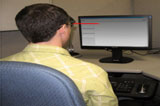Monitor placement
 The monitor should be at arm's length from your body (40 to 70 cm) when you are seated in front of it. The monitor's angle should not exceed 15 degrees to ensure visual comfort and reduce reflection on the screen. The top of the screen should be at eye level. In addition, when looking at the monitor, your head should be in line with your body and in a neutral position, i.e., without requiring you to move your head or neck back or forward.
The monitor should be at arm's length from your body (40 to 70 cm) when you are seated in front of it. The monitor's angle should not exceed 15 degrees to ensure visual comfort and reduce reflection on the screen. The top of the screen should be at eye level. In addition, when looking at the monitor, your head should be in line with your body and in a neutral position, i.e., without requiring you to move your head or neck back or forward.
 If the workstation is close to a window, the monitor should be perpendicular to the window whenever possible. This arrangement reduces the risk of light reflecting from the window on the screen. In addition, the monitor should be placed parallel to and between ceiling lights, and not directly under a light. Note that the department's premises are equipped with reflectors that reduce the risk of glare in your field of vision, and reflection on the screen.
If the workstation is close to a window, the monitor should be perpendicular to the window whenever possible. This arrangement reduces the risk of light reflecting from the window on the screen. In addition, the monitor should be placed parallel to and between ceiling lights, and not directly under a light. Note that the department's premises are equipped with reflectors that reduce the risk of glare in your field of vision, and reflection on the screen.
Harmful consequences of reflection
Reflection on a screen reduces the readability of type, which risks causing eye fatigue or may cause you to sit improperly. To avoid reflection, you can decrease the daylight by using blinds or curtains, and you should clean the screen regularly. If reflection can still be seen, as a last resort, you can use an anti-glare screen. These screens collect a large amount of dust, so they need to be cleaned regularly on both sides.
For individuals who work in customer service, the monitor of their workstation should be positioned slightly off-centre to the right or left so that their head does not need to rotate more than 30 degrees to switch between looking at the monitor and the customer.
Adjusting screen settings
You should be able to adjust the screen's contrast and brightness in order to increase the visibility and readability of text, and thereby also promote the well-being of your eyes. To adjust the screen settings, adjust the buttons that are usually located along the bottom of the monitor.